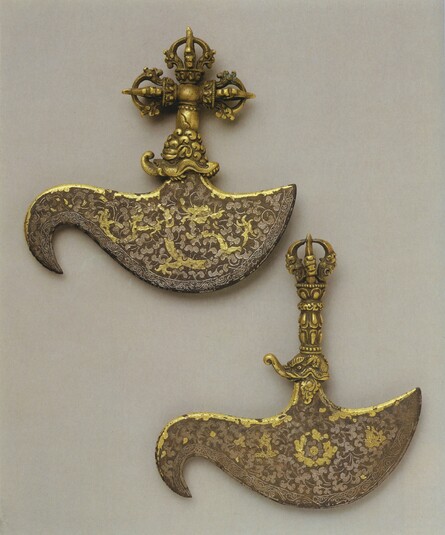
Item: Ritual Object - Curved Knife
| Origin Location | Tibet |
|---|---|
| Lineages | Buddhist |
| Size | 17cm (6.69in) high |
| Material | Metal, Copper Inlay, Gold Inlay |
| Collection | Museum der Kulturen, Basel |
| Catalogue # | acc. #W.lld14105.01+02.R0108 |
Classification: Object/Concept
Curved Knife, or Hooked Knife (Sanskrit: kartari. Tibetan: Tri Gug): a knife with a curved blade commonly depicted in the hands of wrathful and semi-wrathful deities of Tantric Indian religious traditions. In Tantric Buddhism the knife is immediately recognizable because it has a half vajra handle (as opposed to the entire vajra).
The vajra is the principal symbol for Tantric Buddhism. As a physical object it is a small scepter that almost always accompanies a vajra handled bell. The Primordial Buddha Vajradhara holds a vajra in his right hand and a vajra handled bell in the left and folds the arms across the heart in an embracing gesture. Many Tantric deities such as Chakrasamvara and others also hold a vajra and bell in their first pair of hands.
In the past, Western scholars not understanding the function of this knife referred to it as a 'chopper'. It more accurately should be called a curved knife, hooked knife or a flaying knife. In Tibetan literature the curved blade is described for use in skinning demon, human and animal skins/hides and then the hook is used for picking up chunks of cut flesh. The term 'chopper' first used by early Western scholars of Anthropology is quite inaccurate in the present study of Himalayan Style Art and Himalayan and Tibetan Religious Studies as no actual chopping is described in the literature or depicted in the art. Thankfully this term is now rarely used by modern scholars.
Peaceful deities are almost never depicted holding wrathful objects such as the curved knife. The most common deities to hold the curved knife are the Mahakala Class of Wisdom Protectors. Typically in their first pair of hands they hold a curved knife in the right and a skullcup in the left. Semi-wrathful goddesses and Dakinis such as Vajra Nairatmya and almost the entire Vajrayogini Class of Deities hold a curved knife and skullcup.
Jeff Watt, 5-2006
Ritual Object: Curved Knife
Collection of Essen, Museum der Kulturen, Basel
Ritual Object: Main Page
